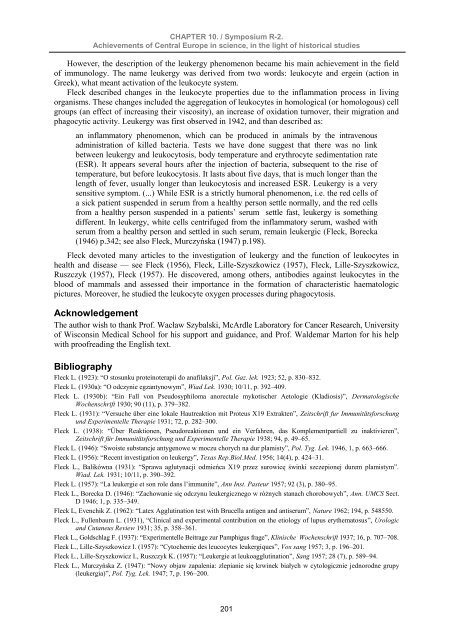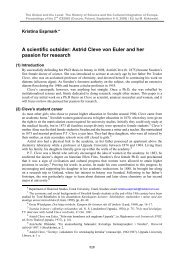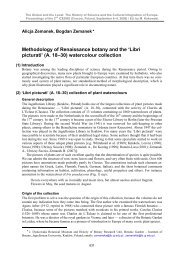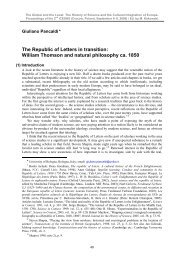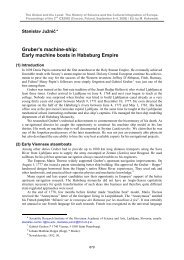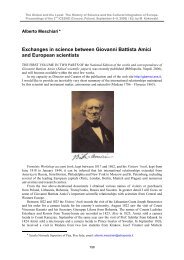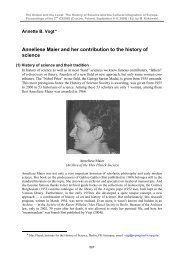Ludwik Fleck as a medical scientist, microbiologist ... - 2nd ICESHS
Ludwik Fleck as a medical scientist, microbiologist ... - 2nd ICESHS
Ludwik Fleck as a medical scientist, microbiologist ... - 2nd ICESHS
Create successful ePaper yourself
Turn your PDF publications into a flip-book with our unique Google optimized e-Paper software.
CHAPTER 10. / Symposium R-2.<br />
Achievements of Central Europe in science, in the light of historical studies<br />
However, the description of the leukergy phenomenon became his main achievement in the field<br />
of immunology. The name leukergy w<strong>as</strong> derived from two words: leukocyte and ergein (action in<br />
Greek), what meant activation of the leukocyte system.<br />
<strong>Fleck</strong> described changes in the leukocyte properties due to the inflammation process in living<br />
organisms. These changes included the aggregation of leukocytes in homological (or homologous) cell<br />
groups (an effect of incre<strong>as</strong>ing their viscosity), an incre<strong>as</strong>e of oxidation turnover, their migration and<br />
phagocytic activity. Leukergy w<strong>as</strong> first observed in 1942, and than described <strong>as</strong>:<br />
an inflammatory phenomenon, which can be produced in animals by the intravenous<br />
administration of killed bacteria. Tests we have done suggest that there w<strong>as</strong> no link<br />
between leukergy and leukocytosis, body temperature and erythrocyte sedimentation rate<br />
(ESR). It appears several hours after the injection of bacteria, subsequent to the rise of<br />
temperature, but before leukocytosis. It l<strong>as</strong>ts about five days, that is much longer than the<br />
length of fever, usually longer than leukocytosis and incre<strong>as</strong>ed ESR. Leukergy is a very<br />
sensitive symptom. (...) While ESR is a strictly humoral phenomenon, i.e. the red cells of<br />
a sick patient suspended in serum from a healthy person settle normally, and the red cells<br />
from a healthy person suspended in a patients‘ serum settle f<strong>as</strong>t, leukergy is something<br />
different. In leukergy, white cells centrifuged from the inflammatory serum, w<strong>as</strong>hed with<br />
serum from a healthy person and settled in such serum, remain leukergic (<strong>Fleck</strong>, Borecka<br />
(1946) p.342; see also <strong>Fleck</strong>, Murczyńska (1947) p.198).<br />
<strong>Fleck</strong> devoted many articles to the investigation of leukergy and the function of leukocytes in<br />
health and dise<strong>as</strong>e — see <strong>Fleck</strong> (1956), <strong>Fleck</strong>, Lille-Szyszkowicz (1957), <strong>Fleck</strong>, Lille-Szyszkowicz,<br />
Ruszczyk (1957), <strong>Fleck</strong> (1957). He discovered, among others, antibodies against leukocytes in the<br />
blood of mammals and <strong>as</strong>sessed their importance in the formation of characteristic haematologic<br />
pictures. Moreover, he studied the leukocyte oxygen processes during phagocytosis.<br />
Acknowledgement<br />
The author wish to thank Prof. Wacław Szybalski, McArdle Laboratory for Cancer Research, University<br />
of Wisconsin Medical School for his support and guidance, and Prof. Waldemar Marton for his help<br />
with proofreading the English text.<br />
Bibliography<br />
<strong>Fleck</strong> L. (1923): ―O stosunku proteinoterapii do anafilaksji‖, Pol. Gaz. lek. 1923; 52, p. 830–832.<br />
<strong>Fleck</strong> L. (1930a): ―O odczynie egzantynowym‖, Wiad Lek. 1930; 10/11, p. 392–409.<br />
<strong>Fleck</strong> L. (1930b): ―Ein Fall von Pseudosyphiloma anorectale mykotischer Aetologie (Kladiosis)‖, Dermatologische<br />
Wochenschrift 1930; 90 (11), p. 379–382.<br />
<strong>Fleck</strong> L. (1931): ―Versuche über eine lokale Hautreaktion mit Proteus X19 Extrakten‖, Zeitschrift fur Immunitätsforschung<br />
und Experimentelle Therapie 1931; 72, p. 282–300.<br />
<strong>Fleck</strong> L. (1938): ―Űber Reaktionen, Pseudoreaktionen und ein Verfahren, d<strong>as</strong> Komplementpartiell zu inaktivieren‖,<br />
Zeitschrift für Immunitätsforschung und Experimentelle Therapie 1938; 94, p. 49–65.<br />
<strong>Fleck</strong> L. (1946): ―Swoiste substancje antygenowe w moczu chorych na dur plamisty‖, Pol. Tyg. Lek. 1946, 1, p. 663–666.<br />
<strong>Fleck</strong> L. (1956): ―Recent investigation on leukergy‖, Tex<strong>as</strong> Rep.Biol.Med. 1956; 14(4), p. 424–31.<br />
<strong>Fleck</strong> L., Balikówna (1931): ―Sprawa aglutynacji odmieńca X19 przez surowicę świnki szczepionej durem plamistym‖.<br />
Wiad. Lek. 1931; 10/11, p. 390–392.<br />
<strong>Fleck</strong> L. (1957): ―La leukergie et son role dans l‘immunite‖, Ann Inst. P<strong>as</strong>teur 1957; 92 (3), p. 380–95.<br />
<strong>Fleck</strong> L., Borecka D. (1946): ―Zachowanie się odczynu leukergicznego w różnych stanach chorobowych‖, Ann. UMCS Sect.<br />
D 1946; 1, p. 335–349.<br />
<strong>Fleck</strong> L, Evenchik Z. (1962): ―Latex Agglutination test with Brucella antigen and antiserum‖, Nature 1962; 194, p. 548550.<br />
<strong>Fleck</strong> L., Fullenbaum L. (1931), ―Clinical and experimental contribution on the etiology of lupus erythematosus‖, Urologic<br />
and Cutaneus Review 1931; 35, p. 358–361.<br />
<strong>Fleck</strong> L., Goldschlag F. (1937): ―Experimentelle Beitrage zur Pamphigus frage‖, Klinische Wochenschrift 1937; 16, p. 707–708.<br />
<strong>Fleck</strong> L., Lille-Szyszkowicz I. (1957): ―Cytochemie des leucocytes leukergiques‖, Vox sang 1957; 3, p. 196–201.<br />
<strong>Fleck</strong> L., Lille-Szyszkowicz I., Ruszczyk K. (1957): ―Leukergie at leukoagglutination‖, Sang 1957; 28 (7), p. 589–94.<br />
<strong>Fleck</strong> L., Murczyńska Z. (1947): ―Nowy objaw zapalenia: zlepianie się krwinek białych w cytologicznie jednorodne grupy<br />
(leukergia)‖, Pol. Tyg. Lek. 1947; 7, p. 196–200.<br />
201


